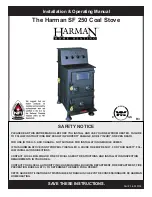
8
OPErATINg INSTruCTIONS
The SF250 is approved for use with coal only.
burning wood or other such fuels in this stove,
except for the purpose of igniting a coal fire, is
prohibited.
Starting A Fire
Begin by opening the draft control knobs on both the
load door and the ash door. Open both doors. Be sure
all items have been removed from the ash pan (i.e.
touch-up paint, warranty registration, etc...)
Place aproximately eight sheets of newspaper, crum
-
bled, on top of the grates. Lay some kindling on top of
the crumbled paper. This kindling should be dry and
no larger than 3/4 in. diameter. It should be layered in
a criss-cross fashion to allow good air flow. Now place
some slightly larger pieces of wood (about 2” diam
-
eter) on top of the kindling. Using a match or grill light
-
er, ignite the paper at the bottom just inside the door.
Close both doors and allow the kindling and larger
wood to catch fire. After around five minutes, open the
load door slightly, for a few seconds and then open
completely. This is a good practice to get into as it
will allow any smoke and gases to clear away from
the door opening. Add small compact pieces of wood
when the kindling is burning hot. When a substantial
bed of hot wood coals is established, start adding
coal in small amounts at a time. Allow a few minutes
between coal loadings to be sure that what you’ve
added is ignited. You can keep the ash door open
through this process, but NEVER LEAVE THE STOVE
UNATTENDED WITH A DOOR OPEN. Once you have
a bed of burning coal, you can load coal into the stove
to the top of the firebricks. Always make sure there is
some flame showing through the coal. This will ensure
the gases are being burned and not accumulating in
the firebox. After a good coal ignition, set the draft
controls on the load door to about /4 turn open. The
draft control on the ash door is used to control the rate
of burn. After starting a fire, keep it about 2 full turns
open for about 30 minutes. Then, adjust further closed
to the proper output level. Normal operation will be
between cracked and one turn open. Since coal re
-
sponds slowly to draft adjustments, make only small
adjustments and allow time in between.
loading
Coal should only be added when there is a reasonably
hot fire. The coal bed should be bright and vigorous.
If the fire is burning hot and there is a deep bed of
coals, full loads can be added. If it is not as described,
add coal in small batches only.
Increasing heat From A low Fire
Every effort should be made not to let a coal fire burn
so long that it has started to die. This will cause the
reloading process to be much longer, and there is a
good posibility of losing the fire.
Do not shake or stir a low fire.
Open the draft control all the way until the fire gets
as hot as possible. Start adding small batches of coal
and follow the instructions for starting a fire.
Once there is a good bed of burning coals, the grates
may be shaken to remove ashes.
Shaking Ashes
Shaking should be done only when there is a hot fire
burning. The frequency of shaking will depend on the
degree of burning. Shaking should be done at least
once per day, preferably twice.
The best results from shaking will occur when short
choppy strokes are used, rather than long, even
strokes. Grasp the shaker handle with one hand and
shake it, only moving the actual handle 1/2 inch or
less. Do this until you start to see hot coals falling into
the ash pan, then stop. Do not rock the grates, as this
will allow burning coal to fall through, and you’ll lose
the fire.
Ashes
The ashes should never be allowed to accumulate in
the ash pan. Excess ash will block the required airflow
through the grates and cause them to warp and sag.
Neglect is not covered by your stove’s warranty.
Ashes should be placed in a metal container with
a tight fitting lid. This closed container of ashes
should be placed on a noncombustible floor or
on the ground, well away from any combustible
materials, pending final disposal. If the ashes are
disposed of by burial in soil, or otherwise locally
dispersed, they should be retained in the closed
container until all cinders have thoroughly cooled.
Fuel
The SF50 is approved for burning anthracite coal.
Pea, Nut, and Stove sized coal are all suitable.
grates
The functions of a grate system are to support the fuel
load, while allowing air flow to the fire in a balanced
amount. Another function is to allow for ash removal
without losing the fire. The SF250 grate system pro
-
vides for all of this and can be removed with no tools
required.
Summary of Contents for SF 250
Page 12: ...testing label 12 This appliance is also approved for installation into a shop...
Page 13: ...13...
Page 14: ...14...
Page 15: ...15 Notes...
Page 16: ......


































